As someone who’s spent years in the trenches of DJ mixing, we understand the importance of having impeccable sound quality for every gig. The heart and soul of any DJ setup are the speakers, and today, we’re diving into the world of the top options available on the market. If you’re on the hunt for the best active speakers, you’re in for a treat. Let’s take a sonic journey together, shall we?
Best Self-Powered Speakers: Our Top 5 Picks
In our fresh new powered speaker review, we’ve sifted through the market’s noise to bring you the crème de la crème of self-powered speakers. Delve into our top 5 selections that not only boast unmatched sound quality but also impeccable design. Discover the audio gems that stand tall in a crowded landscape.
KEF LS50 Wireless II: Best Powered Bookshelf Speakers
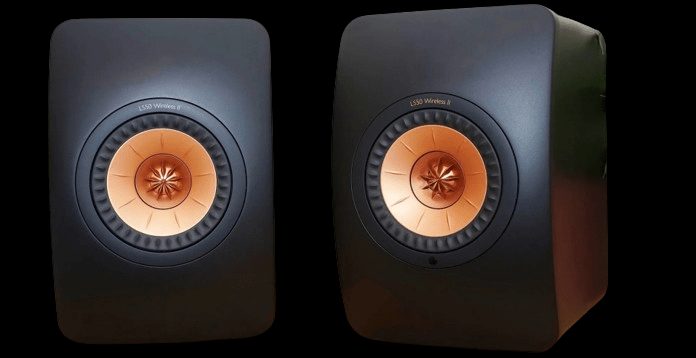
| Power | 760W |
| Inputs | RCA, optical, coaxial, 3.5mm, HDMI eARC, wi-fi streaming |
| Outputs | RCA Subwoofer |
| Bluetooth | 4.2 |
| Frequency response | 45 Hz – 28 kHz |
| Amplification | 380W per speaker |
| Dimensions (H x W x D) | 12.2 x 7.9 x 12 in / 30.5 x 20 x 31.1cm |
| Weight | 44.3 lbs / 20.1 kg |
Pros
- Superior Sound Quality: Renowned as the one delivering crystal-clear audio across a broad spectrum.
- Elegant Design: Modern aesthetics that fit seamlessly into most interior designs.
- Advanced Connectivity: Offers multiple inputs, including wireless options, allowing versatile connections.
- Compact Size: Despite their power, they maintain a relatively small footprint, ideal for various room sizes.
- Dedicated App: Comes with its app ensuring easy customization and control.
- Built-in Amplification: Each speaker houses its amplifier, ensuring optimal sound delivery.
- Uni-Q Driver Array: A proprietary technology of KEF that ensures consistent, detailed sound in any room.
Cons
- Price: On the higher end of the spectrum, which might be out of reach for some budgets.
- Weight: A bit on the heavier side of powered speakers.
- Setup Complexity: Some users might find the setup and calibration process somewhat complex, especially without prior experience.
- Requires Power Source: Each speaker needs its own power source, which could be a limitation with some setups.
Every once in a while, a product emerges that revolutionizes the DJ mixing scene, and the KEF LS50 Wireless II is undeniably one such marvel. As an experienced DJ, I’ve encountered my fair share of powered speakers, but few have struck a chord quite like this model. It’s the perfect blend of tradition and innovation, a testament to KEF’s mastery in delivering truly Hi-Fi sound quality.
The first thing you’ll notice is its sleek design – modern yet timeless. But it’s the audio clarity that’s truly mind-blowing. Whether I’m mixing deep house tracks or playing ambient lounge music, the LS50 ensures each note is crystal clear, with lows, mids, and highs perfectly balanced. The wireless capabilities mean a cleaner setup, devoid of pesky cables, which is always a win.
The LS50 Wireless II power speaker is presented in KEF’s classic shades of Carbon Black, Titanium Grey, Mineral White, and vibrant Crimson Red, with the choice of complementary stands. KEF’s distinctive copper-toned Uni-Q driver pairs a 1-inch vented aluminum-dome tweeter centrally within a 5 ¼-inch magnesium-aluminum alloy bass cone, ensuring an expansive audio sweet spot. Its bass-reflex design, combined with elliptical rear ports, is crafted to enhance the depth and accuracy of the bass.
Meanwhile, the Metamaterial Absorption Technology (MAT) used alongside the unique 12th-generation drivers effectively eliminates undesired reverberations, reducing distortion. Drawing a parallel, just as the JBL 4305P stands out for its detail and dynamism, the LS50 Wireless II is immersive and captivating. One immerses you in every melody, while the other lets your senses drift. The choice between these proficient two-way competitors might be influenced by your inclination towards either a sharp/bright or a wholesome/rounded auditory experience.
Klipsch R-15PM: Best Powered Loudspeakers
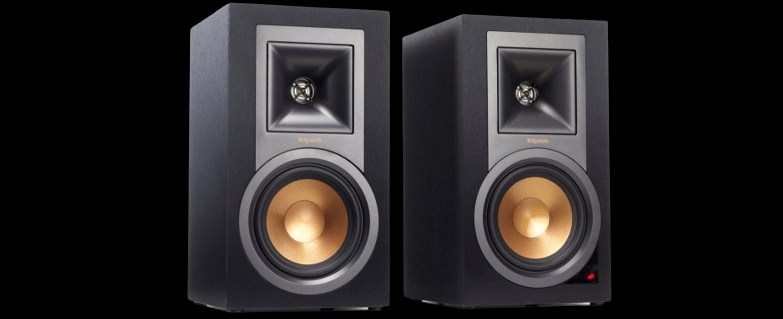
| Power | 50W |
| Inputs | 1 x RCA Pair (switchable phono/line) 1 x USB 1 x Optical 1 x 3.5mm Analogue Jack 1 x Bluetooth |
| Outputs | 1 x RCA Sub Out |
| Bluetooth | Bluetooth® wireless technology11111 |
| Frequency response | 62 Hz – 24 kHz |
| Amplification | A built-in, ultra-low noise 50 W x 2 channel amplifier |
| Dimensions (H x W x D) | 12,5 x 7 x 8.11 in / 31.811 x 7.8 x 20.6 cm |
| Weight | 10.3 lbs / 4.67 kg |
Pros
- Dynamic Sound: Klipsch’s renowned for delivering punchy and clear audio, and the R-15PM is no exception.
- Built-in Phono Preamp: Perfect for vinyl enthusiasts, making turntable connections seamless.
- Versatile Connect: Offers multiple inputs, including Bluetooth, for wireless streaming.
- Compact Design: Ideal for various room sizes and setups without compromising sound quality.
- Tractrix Horn Technology: Ensures efficient and detailed audio reproduction, a signature of Klipsch.
- Aesthetics: The classic, stylish wood finish complements most interior designs.
Cons
- Bass Response: Some users may find the bass lacking or not deep enough without an additional subwoofer.
- No Remote: Depending on the version, some users have noted the lack of remote control.
- Price: It’s on the higher end compared to other powered speakers in its class, which might not fit all budgets.
- Size: While compact, they are still larger than some competitive bookshelf powered speakers.
The Klipsch R-15PM power speaker, those nifty little powerhouses, pack a punch with 50 watts per channel, filling spaces with rich sound while maintaining a remarkably compact profile. Within each, you’ll find a 1-inch aluminum diaphragm compression driver, masterfully paired with Klipsch’s iconic square Tractrix horn. From personal experience, this fusion guarantees an expansive soundstage and impeccably sharp highs. The uniquely crafted 5-¼-inch spun copper woofer nails the midrange, while the rear-firing port adds depth to the bass. And all this audio magic is encased in sturdy MDF cabinets, ensuring the sound remains pristine, free from any unwanted resonance.
Retailing at a budget-friendly $275 a pair, these powered speakers truly impress with their comprehensive feature list and robust sound delivery. From personal use, I can attest that setting them up is as straightforward as it gets. Seamlessly plug into various audio devices, be it your latest tablet or your widescreen TV. Their built-in phono preamp, Bluetooth features, diverse analog and optical digital ports, along with a USB Type B input ensure broad compatibility. The cherry on top? A handy remote that, for me, has been a savior for controlling volume and toggling between inputs, all while I’m comfortably lounging. Oh, and let’s not forget the crisp high-frequency sounds they produce; it’s like music to my ears!
JBL 4305P: Top Powered Speakers With Subwoofer
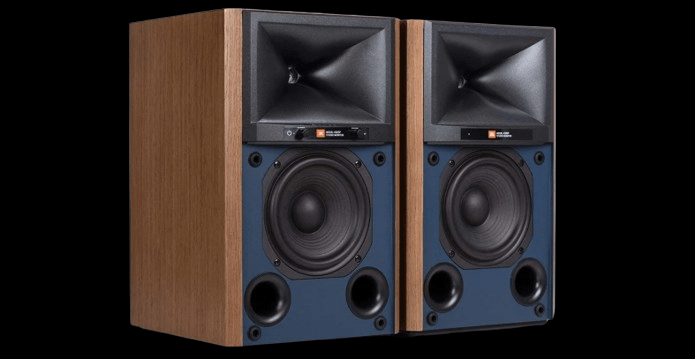
| Power | 300W |
| Inputs | USB and optical digital inputs plus XLR / ¼-inch TRS and 3.5mm analog inputs |
| Outputs | Autosensing w/ Auto-engage of 80Hz High Pass Filter1 |
| Bluetooth | Version 5.1Profiles: SPP (Serial Port Profile) A2DP (Advanced Audio Distribution Profile) AVRCP (Audio/Vido Remote Control Profile) |
| Frequency response | 45 Hz – 25 kHz |
| Amplification | 300 W rms |
| Dimensions (H x W x D) | 13,2 x 8,3 x 8,8 in / 33,5 x 21 x 22,4 cm |
| Weight | 14.6 lbs / 6.6kg |
Pros
- Superior Sound Quality: JBL has a reputation for delivering crisp and clear audio, and the 4305P meets that standard.
- Streamlined Design: A sleek and modern look seamlessly fits various room aesthetics.
- Versatile Connectivity: Offers multiple input options, including Bluetooth, catering to different audio devices.
- Efficient Amplification: The built-in amplifier ensures consistent power delivery and sound reproduction.
- Compact Size: Making it versatile for different room sizes and setups without compromising on audio quality.
- Brand Reliability: JBL is a recognized brand in the audio industry, known for its durability and performance.
Cons
- Price: Being a part of the premium segment, it might be on the pricier side for some users.
- Bass Response: While adequate, some users might desire a deeper bass which could necessitate an external subwoofer.
- Weight: Depending on its specs, it might be on the heavier side compared to other bookshelf powered speakers.
- Physical Controls: Some users might prefer more tactile controls or a more intuitive remote.
Decked out in its stunning walnut finish (as you can see with its grille off), the 4305P seeks to capture the essence and vitality of a towering floor speaker, all while retaining the elegance of a stand mount. Drawing from JBL’s innovative transducer tech, each unit boasts a 2410H-2 1-inch compression driver paired with a High-Definition Imaging horn, ensuring those high notes hit with impeccable clarity and true-to-life vigor.
Not to be outdone, its 5.25-inch cast-frame, fiber-composite cone woofer, coupled with its bass-reflex design and dual front-firing ports, handles low-frequency sounds with grace and depth. Its inbuilt Class D amp impressively doles out 25W to each driver and a whopping 125W to every woofer, summing up to an overall system strength of 300W rms. Having used it myself, the bass contour control comes as a savior, particularly in setups where the speaker’s proximity to walls might affect acoustics. Furthermore, the savvy signal-sensing subwoofer output, with its high-pass 80Hz filter, gives the powered speakers the room they need to perform optimally. Truly, an aural masterpiece!
Crafted meticulously from sturdy 3⁄4-inch MDF, complemented with internal bracing, the 4305P showcases a timeless wood veneer finish. You have choices – a Natural Walnut hue paired with a contrasting blue grille, or the classic Black Walnut accompanied by a sleek black grille. Having seen it firsthand, the 4305P exudes such a class that it fits seamlessly beside a mixing console yet feels equally inviting when placed opposite your favorite relaxation nook.
Kanto YU6: Top Powered Speakers for Turntables
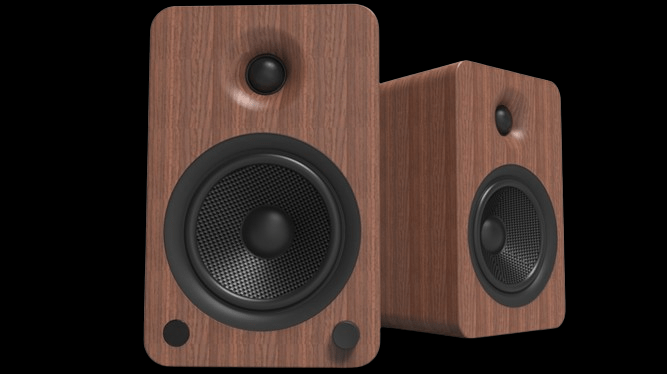
| Power | 200W |
| Inputs | 1 x 3.5 mm stereo mini-jack AUX1 x RCA L/R2 x Optical (Toslink) |
| Outputs | 1 x Subwoofer1 x USB Charge Port 5 V 1.0 A |
| Bluetooth | 1 x Bluetooth® 4.0 with Qualcomm aptX |
| Frequency response | 150 Hz – 20 kHz |
| Amplification | 100W rms |
| Dimensions (H x W x D) | 13.98 x 6.89 x 10.71 in / 35,5 x 17,5 x 27,2 cm |
| Weight | 7.6 lbs / 8 kg |
Pros
- Comprehensive Connectivity: The YU6 offers a variety of inputs including Bluetooth with aptX technology, phono input, and multiple analog and digital connections.
- Built-in Phono Preamp: Ideal for vinyl lovers as it can be directly connected to a turntable.
- Compact Design: Modern, sleek aesthetic that fits into various room decors.
- Remote Control: Comes with a full-function remote, enhancing user convenience.
- Rich Bass: Despite its size, it provides a substantial bass response.
Cons
- Bass Precision: While it provides good bass, audiophiles might find it lacks a bit in terms of precision at higher volumes.
- Size: Some users might find them slightly larger for desktop use.
- Soundstage: While suitable for its size, it might not replicate the expansive soundstage of larger systems.
I often get hit with the question, “Are powered speakers apt for vinyl?” Drawing from my own experiences and the live sound nuances vinyl brings, I can confidently vouch for the Kanto YU6, priced at $379/pair. Not only does it excel in handling analog vibes with its RCA and 3.5mm inputs, but it also seamlessly bridges the digital world with a toggle-friendly phono preamp/line-in, optical TOSLINK provisions, and robust Bluetooth 4.0 streaming backed by aptX support. A true gem for every audiophile’s collection!
Vinyl lovers will immediately appreciate the YU6’s rear-panel RCA stereo slot, presenting a toggleable option between a moving magnet phono preamp-in and a standard analog line-in. Modern tech enthusiasts will find the optical inputs tailored to their TV, CD player, or gaming console’s digital audio desires. Additionally, a convenient USB port charges devices and anyone yearning for richer bass can use the subwoofer output combined with a 200 Hz lowpass filter to incorporate a standalone sub, enhancing the overall depth.
A little tip from my own setup adventures: When using the YU6 power speakers for that nostalgic turntable playback, I’ve found it wise to give your turntable and cabinets their own space—either on different pieces of furniture or stands. Alternatively, investing in a turntable platform can be a game-changer to keep those pesky vibrations in check. Trust me, your records will thank you!
Bose L1 Pro8: Best Powered Bluetooth Speakers
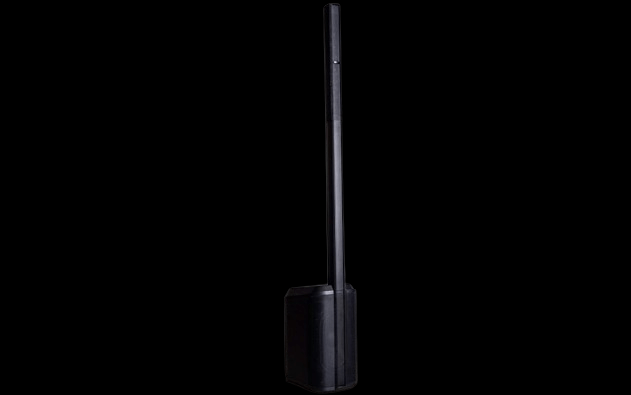
| Power | 120W |
| Inputs | 2x 6.35mm XLR combo with phantom power, 1x 3.5mm Aux and Bluetooth |
| Outputs | XLR Line Out |
| Bluetooth | 4.2 with aptX |
| Frequency response | 45 Hz – 16 kHz |
| Amplification | 60W (driver array), 280W (subwoofer) |
| Dimensions (H x W x D) | 45.7 x 12.5 x 17.9 in / 116.08 x 31.75 x 45.47 cm |
| Weight | 39.02 lbs / 17.7 kg |
Pros
- Compact Design: Ideal for performers on the move, its design makes it easy to set up and pack away.
- Comprehensive Coverage: The line array design ensures the sound is dispersed evenly across the audience.
- Integrated Mixer: It comes with an onboard mixer, eliminating the need for external equipment.
- Bluetooth Connectivity: Enables easy streaming and control from mobile devices.
- Versatile Inputs: Accommodates various sound sources, from instruments to microphones.
Cons
- Price Point: Bose products typically come at a premium, which might not suit everyone’s budget.
- Bass Response: While adequate for many settings, some users might desire a more potent low-frequency punch.
- Proprietary Accessories: Some accessories or replacements might be brand-specific, limiting third-party options.
- Weight: Though designed with portability in mind, it might be heavier than some alternative portable systems.
The L1 Pro8, priced at $1,199, is the most travel-friendly member of the Pro series and a top choice for both singer/songwriters and discerning DJs. This system boasts a unique C-shape 8-driver array that offers a sweeping 40-degree vertical and 180-degree horizontal sound coverage. Additionally, its built-in subwoofer, fitted with a RaceTrack driver, guarantees punchy low-frequency output, rivaling the depth of traditional 12-inch woofers while maintaining a sleeker design.
As someone who appreciates intuitive volume control, I was pleased to see that each L1 Pro model comes equipped with a 3-channel mixer. Channels 1 and 2 accommodate signals from combo XLR/TRS jacks (complete with phantom power). In contrast, Channel 3 flexibly accepts inputs from a 1/8-inch headphone jack, a ¼-inch TRS jack, or even Bluetooth while those wireless streaming sessions. It’s a versatile audio companion for any occasion!
This setup is a breeze to assemble and user-friendly, delivering a robust auditory experience. With 60 watts of Class D amplification fueling the speaker array and an impressive 240 watts energizing the subwoofer, you can expect a peak SPL of 118 dB. From my own experiences, the Bose L1 Mix App is a game-changer. It allows you to fine-tune mixes and play around with effects, including Bose’s curated ToneMatch collection of EQ presets, no matter where you’re stationed in the room.
Comparing Powered Speakers vs. Passive Speakers: What’s the Difference?
In the audio world, the debate between powered (or active) speakers and passive speakers is ever-present. But what sets them apart? At a glance, powered speakers come with a built-in amplifier, streamlining the setup process and eliminating the external amp need. This is particularly handy for those with limited space or who prefer a more straightforward setup.
Conversely, passive speakers demand an outside amplifier to operate. This presents an opportunity to blend different components, aiming at specific audio outcomes. Yet, it can lead to additional gear and increased intricacy. Both types present distinct advantages, and the final choice typically hinges on individual tastes, the purpose of use, and the setting. Grasping the fundamental contrasts between powered and passive speakers is vital when it comes to sound selection, whether you’re drawn to the ease of the former or the adaptability of the latter.
Final Thoughts
It’s evident that the audio industry continues to evolve, offering a plethora of options tailored to the unique needs of DJs. Whether you’re a seasoned pro or just starting out, there’s a powered speaker on this list that’s bound to resonate with your specific requirements. Remember, investing in the right powered speakers can elevate your sets, ensuring that every beat and rhythm is heard with precision. Take your time, weigh your options, and let your music passion guide your choice. Here’s to dropping unforgettable tracks and keeping the dance floor alive and kicking all year long!


